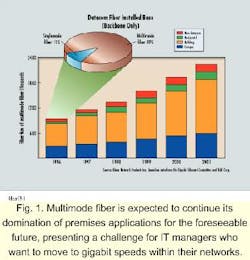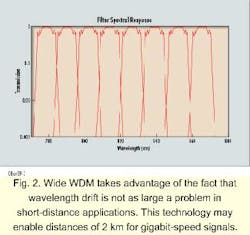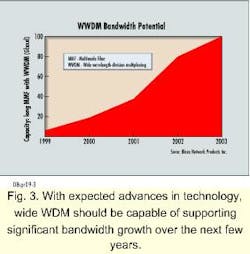Loca-area WDM solutions: How fast, how far, how soon?
Wavelength-division multiplexing (WDM) used to be the exclusive domain of deep-pocket network owners-the long-distance telecommunications providers. Not any more. Today, this technology is being harnessed for local- and metropolitan-area networks. New techniques are making WDM cost-effective enough to address today's enterprise network bandwidth and distance constraints.
You can blame it on the Internet, but the bandwidth problem in local-area applications really began before that. Enterprise networks are experiencing explosive growth, thanks to computers with hundreds of megahertz of processing power, ever-more-hungry business applications, and multi-megabyte data files. The Internet has only exacerbated the problem.
The Internet's pervasiveness has made hash of traditional networking strategies. High volumes of bursty Internet protocol (IP) traffic are swamping corporate networks, wreaking havoc with the best-laid bandwidth-management plans. Add legacy data, video, and voice to a growing base of business-critical IP applications as well as users' zero-tolerance for delay and you have a recipe for high recurring bandwidth costs. Unfortunately, while the number of users is increasing at 50% per year and bandwidth demands are growing at 90% per year, the average information-technology (IT) budget is growing at only 10% annually.
If you're an IT manager, you have our sympathy. You're living under intense pressure to find cost-effective ways of maximizing existing premises-network bandwidth and extending its reach.
Most network managers have already begun to deploy optical fiber in premises networks. Optical fiber is the key medium for Gigabit Ethernet and Fiber Distributed Data Interface (FDDI), which exists in 50% to 70% of network backbones, according to Telecommunications, July 1998. In fiber, IT managers have found their weapon of choice for futureproofing a network against insatiable bandwidth demand. To sweeten the pie, the cost of fiber-based networks is plummeting toward parity with wire-based networks.
Already, approximately two million fiber links connect premises-network backbone nodes (switch-to-switch or switch-to-router) located anywhere from 1 m to 2 km apart (Electronics Industry Year Book, Cahners, 1999). The trend toward fiber will continue-and grow. Now that the decision is no longer between fiber and wire, the question becomes "what type of fiber"-and exactly how much futureproofing can fiber deliver?
To date, the fiber of choice in premises networks has been multimode fiber (MMF). More than 80% of premises backbone fiber links are MMF (Gigabit Ethernet Committee Study, 1996; see Fig. 1). The trend toward MMF is expected to continue (see Lightwave, January 1999, page 72). Multimode fiber-based premises networks are ideal for entrenched local area network (LAN) protocols including 10Base-T Ethernet, Fast Ethernet, and FDDI. It's only natural that businesses are migrating along the same technology path-from Ethernet to Fast Ethernet.
Gigabit Ethernet is the logical next step. Notice we didn't say "small" step. The fact is that MMF can support Gigabit Ethernet speeds at up to 550 m. Unfortunately, more than 40% of the installed links exceed that distance (Gigabit Ethernet Committee Study, 1996). What would seem to be a simple step forward along a known path will actually require important decisions by IT managers about their existing fiber infrastructures.
To upgrade to Gigabit Ethernet, it would appear that IT managers must pull new singlemode fiber (SMF) for links longer than 550 m. And as work begins on the new 10-gigabit standard, the problem becomes more severe and the motivation stronger. It's not likely that a multimode 10-Gbit serial standard using current technology would be capable of even 100 m. The primary advantage of SMF is distance-it can achieve high data rates (currently up to OC-256 or 13.271 Gbits/sec) over very long distances. SMF, unlike MMF, propagates light pulses along a single optical path, or mode. Because there is only one path, all photons (the counterpart to electrons in copper wire) in a pulse arrive at the destination at the same time, maintaining signal integrity.It is difficult, however, to guide light into an SMF. As a result, network interface cards that connect to SMF require expensive light sources and precise mechanical alignment. For this reason, SMF cards are often priced 200% to 300% higher than MMF cards. SMF is also expensive to terminate because it requires special connectors, equipment, and specially trained personnel to attach those connectors. Moreover, installing SMF over long distances can require extensive infrastructure excavation.
For long-distance service providers who typically deploy SMF, fiber termination and interfacing costs are relatively insignificant compared to the huge expense and difficulty associated with actually laying and maintaining fiber hundreds of kilometers long. Enterprise IT managers, with numerous ports to manage and limited budgets, cannot afford solutions with such a high cost of ownership.Another alternative is to avoid deploying Gigabit Ethernet and change networking technologies altogether. Asynchronous Transfer Mode (ATM) has been touted as an alternative with higher speeds and bandwidth-management capabilities. But ATM terminals are even more expensive than singlemode terminals, harder to manage, and better suited for wide-area backbones than for LANs.
Which brings us back to square one. The higher costs for deployment, management, network components, and training required by SMF or ATM make these rather poor second choices for most IT managers. Gigabit Ethernet is the most obvious, familiar, and desirable choice for expanding and extending existing premises networks. Fortunately, there are promising new technologies around the corner that will allow MMF to scale its capacity through several orders of magnitude.
One of the most exciting developments for LANs is WDM technology. WDM has been deployed in SMF environments-primarily in long-distance carrier networks-for some time. Several large WDM systems designed for telecommunications applications can place 80 or more colors of light on a single fiber. As a protocol-independent technology, WDM could be used for Ethernet, FDDI, ATM, and other network architectures, effectively multiplying existing capacity by one or two orders of magnitude. The disadvantage of WDM systems to date has been cost. WDM costs several thousand dollars per channel to implement, putting WDM systems out of range for most enterprise IT managers.
However, new materials and techniques hold promise for bringing WDM capabilities within the budget of every IT manager.
New materials and techniques: New developments in materials and techniques are allowing manufacturers of optical-networking components to reduce the cost of WDM systems. Multiplexers, or waveguides, are transparent, non-electrical-conducting structures that combine multiple wavelengths onto a single medium. Wavelengths can be added one at a time or all can be combined simultaneously-how that occurs determines the cost of a WDM system.
Polymer is a new material being used for reducing the cost of developing waveguides. Polymer's inherent properties make it highly versatile-able to be used in a wide range of processes and applications. At the same time, polymer provides the stability required for high-volume, low-cost production. Polymers can work with either singlemode or multimode waveguides and are flexible enough for use in rigid circuit boards, flexible circuitry, or stand-alone fiber-coupled components.
The Polymer Optical Interconnection Technology (POINT) program, funded by the Defense Advanced Research Projects Agency and DuPont Corp., has made huge strides in polymer waveguide technology. For example, DuPont developed Polyguide, an optical waveguide technology that produces singlemode and multimode waveguides in film sheets that are laminated between multiple surrounding polymer film layers. These optical channels route light signals wherever they need to go and can replace a complicated assembly of fiber optics (Polyguide Polymeric Technology for Optical Interconnect Circuits and Components, Bruce L. Booth, Joseph E.Marchegiano, C.T. Chang, R.J. Furmanak, D.M. Graham, R.G. Wagner, DuPont Company, www.polymerphotonics.com/paper.htm).
New processes enable mass production of precoated polymer materials, which are reliable and reproducible for use in Polyguide waveguide structure assembly. Because precoated polymer can be manufactured and stored as large rolls (100 ft or more), it can be used for everything from circuit-board-sized circuitry to multiple imaged components-with significant unit-cost processing savings.
Another material and process is known as Sol-Gel, originally from Sandia Laboratories and now commercially available. Sol-Gel processing is a low-temperature solution for manufacturing a wide range of conductors, among them glass and ceramic thin films. These thin films can be customized by controlling their composition and microstructure for use in a wide variety of applications, including microelectronics and optics. With Sol-Gel, wave-guides can be fabricated via a standard mask-and-exposure system, driving down the processing-cost basis to one comparable with fabrication of silicon integrated circuits.
Using a different approach, wavelengths can be multiplexed through a series of reflections where a wavelength is added on each "bounce." Components can now be fabricated from plastic. Plastic components, unlike Polyguide and Sol-Gel, can be produced using inexpensive injection-molding techniques-the same process used to make 25-cent toys, though with more precision. Today, plastic components are used with standard, single-channel Gigabit Ethernet modules to guide light into fiber and will soon find their way into WDM systems.
Connectorization leverages high tolerances: Connectorization, the process of making fiber cables plug-capable, requires precise alignment of optoelectronic devices with optical fibers. Singlemode coupling involves a 9-micron fiber and submicron tolerances and a two-step process. On the other hand, MMF involves 50- or 62.5-micron fiber and a similar process, but with +10-micron tolerances. The 10x difference in assembly tolerances results in a significant cost savings for MMF connectorization-savings that can be passed onto the WDM system.
Wider is better: Another advance in WDM technology reduces cost by increasing the wavelength spacing between channels. In SMF systems, channels are separated by 1 to 2 nm. This requirement maximizes the number of channels in the bandwidth of erbium-doped fiber amplifiers (EDFAs). Operating temperatures in a WDM system can cause lasers to drift several degrees, resulting in wavelength shifts of several nanometers. Closely spaced channels will then experience crosstalk. To avoid crosstalk, cooling devices are used to dissipate heat and control the laser temperature within a few degrees.
But for short-distance LANs, EDFAs are not necessary, eliminating the requirement for narrow channel spacing. Increasing channel spacing to 10 or 20 nm also eliminates the need to control laser temperature. By spacing channels wider, the lasers' wavelength can drift with temperature without adverse effects on other channels. This wider channel spacing is being incorporated in WDM solutions to reduce costs and is known to some as "wide WDM" (WWDM; see Fig. 2).
New laser technologies: Large strides are also being made in the area of laser technology. Currently, the most inexpensive fiber-optic transceivers use vertical-cavity surface-emitting lasers (VCSELs) as the light source. VCSELs are fabricated using standard high-volume semiconductor processes, making them very inexpensive. Until recently, however, the process only produced lasers operating at 850 nm. WDM requires multiple wavelengths, and new advances in VCSEL technology have produced a wider variety of wavelengths and better control over wavelength tolerances. With better control, higher yields are possible. The new VCSEL technology is capable of producing lasers that operate from 790 to 860 nm, each at +2 nm. At 10-nm spacings, VCSEL-based systems could be used for an 8-channel WDM system.
Several companies are also developing new types of VCSELs that operate at a longer wavelength with less susceptibility to modal dispersion. VCSELs that operate at 850 nm are limited to less than 300-m transmission distances because of differential modal delay problems. However, these new longer-wavelength VCSELs deliver reduced modal dispersion while maintaining the low cost profile. Simply changing lasers will double the distance performance of MMF systems without increasing overall system costs.
Advanced modulation schemes put more data on each wavelength: In an exciting new development, some WDM systems may now include Multilevel Analog Signal (MAS) encoding schemes to increase the distance at short wavelengths. MAS is currently used in both 100-Mbit/sec and Gigabit Ethernet twisted-pair standards to increase data capacity without increasing the signaling rate or required bandwidth. This same technique can be applied to fiber-optic transmission to an even greater extent, because fiber is much less susceptible to noise and crosstalk than twisted-pair copper wire. New multilevel encoding technology could increase the capacity of each optical channel by four, reducing the clock-rate by a factor of four. The result is a 400% improvement in transmission distance-with little additional cost since the required circuitry will be implemented in application-specific integrated circuits.
The upshot of these advances in WDM technology is outrageous scalability at scandalously lower costs. Multiplexers will evolve to support up to 16 or 32 channels, and multilevel encoding techniques will add 4 to 16 bits per baud. These capabilities will allow component and device manufacturers to combine channels and layers for a dazzling array of feature and performance combinations. By combining different ways of multiplexing and demultiplexing lightwaves, WWDM will scale to 10, 30, and probably 40 Gbits/sec, while maintaining the 2-km distance capability (see Fig. 3). Further advancements may enable 100 Gbits/sec at 2 km over MMF.
It's not far in the future, either. Companies have been working on WDM for premises fiber for several years. Hewlett-Packard demonstrated a 4-channel 850-nm WDM system last year and is working on a 4-channel, 1300-nm version this year. ADVA Optical Networking (a manufacturer of singlemode stand-alone WDM systems) and MRV Communications have announced singlemode WDM systems for premises networks.
Other WDM solutions will extend Gigabit Ethernet over 2 km of MMF. Using special electronics, the gigabit data stream is divided into eight parallel optical channels, each of which requires one-eighth the bandwidth of the original data stream. These eight optical channels can be transmitted much farther than a single Gigabit Ethernet stream since they are less susceptible to modal dispersion as a result of their lower bandwidth. At the other end of the fiber, the original gigabit stream is reconstructed. This breakthrough will allow network managers to upgrade FDDI and Fast Ethernet fiber plants to Gigabit Ethernet without difficulty.Within a year, these solutions will be able to increase transmission over existing LAN backbones by four to eight times. At the same time, they will provide IT managers with a well-defined migration path from 1 to 10 Gbits/sec and beyond, allowing them to readily upgrade as enterprise needs dictate. For manufacturers and end users alike, these WDM breakthroughs enable standards-based Gigabit Ethernet solutions that upgrade existing FDDI and Fast Ethernet fiber plants without difficulty.
Clearly, MMF is able to meet today's-and tomorrow's-network requirements. With the installed base of MMF and its low cost of ownership, it makes sense to leverage those large investments as much as possible.
As networks migrate to Fast Ethernet and Gigabit Ethernet technologies, new WDM-based technologies promise to solve the capacity and distance issues that arise. Optoelectronic solutions combine the power of electronic and optical networking to secure MMF as the primary medium for premises backbone networks and allow network managers to tap its full potential. u
Brian C. Peters is president and Ken Herrity is director of product development at Blaze Network Products (Dublin, CA).



